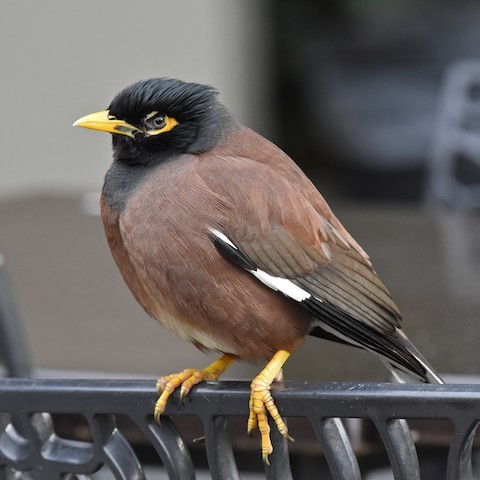Birdfinding.info ⇒ A high tolerance for urban environments and fast food has allowed the Common Myna to become one of the most successful invasive bird species globally. It is abundant throughout most of its natural range and in many areas that it has colonized from the 1800s onward—especially tropical islands such as Hawaii, Fiji, Tahiti, New Caledonia, the Seychelles, and Mauritius, and other havens for non-native birds such as Israel, the U.A.E., Taiwan, and North Island, New Zealand. In the U.S., it is common and conspicuous throughout southeastern Florida, especially from Miami to Key West, and may be the most numerous landbird on the main Hawaiian Islands.
Common Myna
Acridotheres tristis
Native to central and southern Asia; widely introduced elsewhere. A habitat generalist that thrives in various semiopen habitats, including cities and other developed areas.

Approximate natural range of the Common Myna. © BirdLife International 2017
Natural Range. From southern Kazakhstan south through eastern Iran, then east across the Indian subcontinent, Sri Lanka, and throughout Southeast Asia to southern China and Hainan, and south to the tip of the Malay Peninsula.
Introductions. Human-associated populations are established and expanding in several regions.
In Eurasia, it appears to have expanded its natural range westward to the Mediterranean coast (to western Turkey and Israel), including much of the Arabian Peninsula, east to Taiwan and south to northern Borneo and Java. There are small outpost populations in the southern Rhone valley of France; along the Iberian coast of Portugal and southwestern Spain; and in Japan’s Ryukyu Islands and central Honshu.
Around the Indian Ocean, it has colonized most of the settled islands, including the Maldives, Seychelles, Comoros, Mauritius, Réunion, Rodrigues, and Madagascar, as well as southeastern Africa from Zambia to Cape Town, South Africa.
Around the Pacific Ocean, it has colonized eastern Australia (Queensland to Victoria, and expanding in both directions), New Zealand (mainly North Island, but expanding south), New Caledonia, the Solomon Islands, and most of the major Polynesian island groups east to the Marquesas and north to Hawaii.
In the South Atlantic, populations are established on Ascension and St. Helena. In the Caribbean, it is well-established in southern Florida (north to Cape Coral, Lake Okeechobee, and Jupiter) and has been found in small numbers north to Pensacola and south to Havana, Cuba.
Identification
A medium-large, sturdy, brown myna with a blackish hood, white belly, yellow bill and legs, and a patch of bare, yellow skin behind and below the eye (the suggestion of a tear being the source of its scientific name, tristis, meaning sad).

Common Myna. (Fatehpur Sikri, Agra, Uttar Pradesh, India; November 26, 2010.) © Tomas Grim
Overall coloration varies across a wide spectrum of browns: from warm to cold and pale to blackish. The Sri Lankan population is recognized as a separate subspecies, melanosternus, and is blacker overall than others.
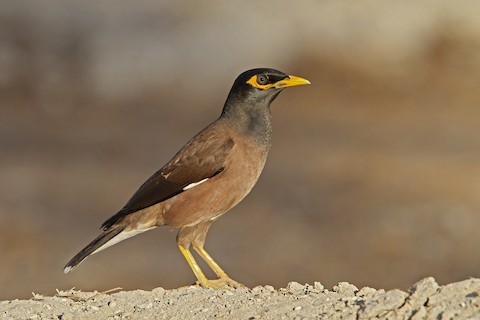
Common Myna, typical coloration. (Barbar, Ash Shamaliyah, Bahrain; November 2, 2010.) © Christoph Moning

Common Myna, a pale, warm-brown individual. (Kubang Semang, Pulau Pinang, Malaysia; March 20, 2019.) © Neoh Hor Kee
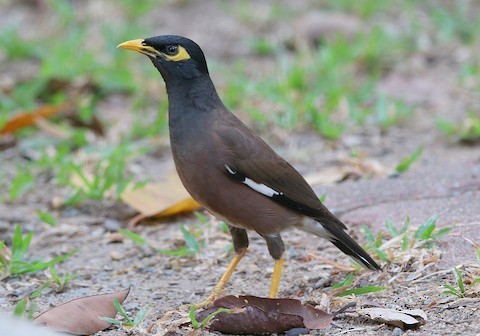
Common Myna, a mostly dark-brown individual. (Lumphini Park, Bangkok, Thailand; March 8, 2019.) © Tim Avery
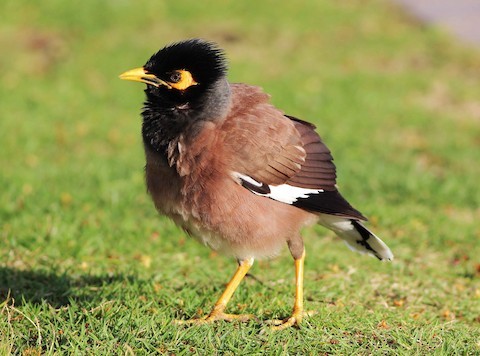
Common Myna, a pale, warm-brown individual. (Georgetown, Penang, Pulau Pinang, Malaysia; April 27, 2018.) © Neoh Hor Kee
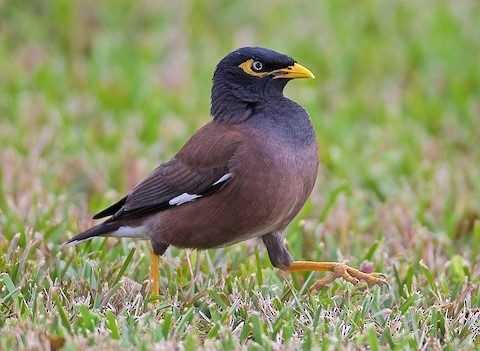
Common Myna. (Florida City, Florida; February 6, 2015.) © Dave Allen
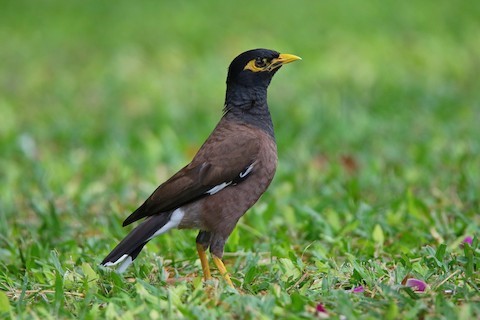
Common Myna. (Kuhio Beach Park, Waikiki, Honolulu, Hawaii; July 25, 2017.) © Thanasis Tsafonis

Common Myna, a mostly blackish-brown individual without a black hood. (Al Wakrah, Qatar; June 29, 2010.) © John Thompson
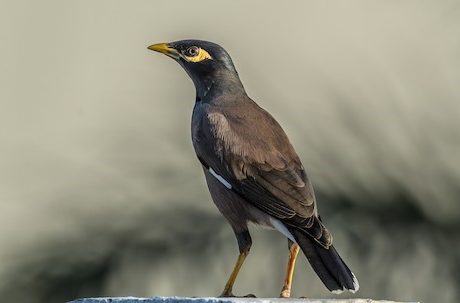
Common Myna with an indistinct hood. (Green Park Extension, New Delhi, India; April 1, 2019.) © Nitin Chandra
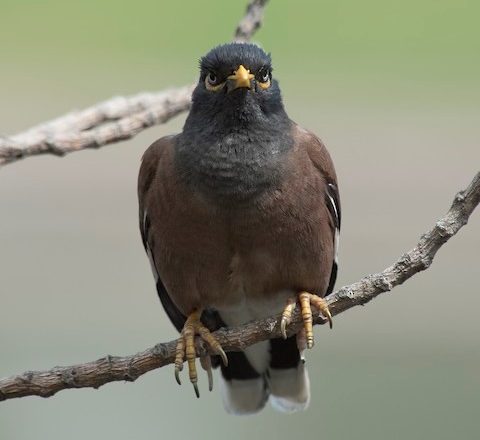
Common Myna, showing white belly and vent and white-and-black undertail. (Birrarung Marr, Melbourne, Victoria, Australia; January 27, 2019.) © Dan Forster
The tail feathers are black with white tips, such that, when folded the undertail appears mostly white with black at the base, and when spread it appears mostly black with white tips. On its upperside, the tail appears dark-brown with white tips that appear broader at the corners.
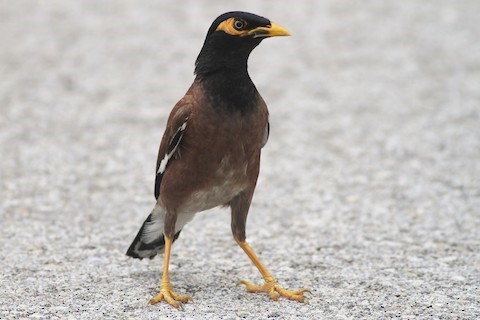
Common Myna, showing white belly and vent and white-and-black undertail. (Marathon, Florida; July 21, 2016.) © Alex Lamoreaux
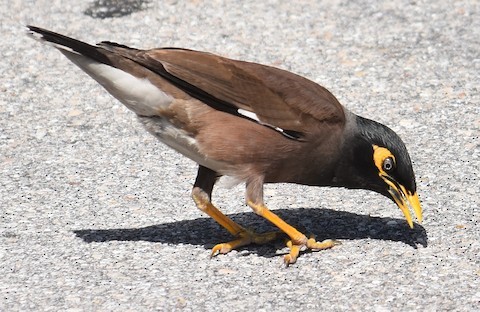
Common Myna, showing white belly and vent. (Boynton Beach, Florida; April 13, 2018.) © Chuck Hignite

Common Myna, a cold-brown individual, showing white-tipped uppertail. (Westmead, New South Wales, Australia; March 24, 2019.) © Terence Alexander

Common Myna, close-up showing yellow-and-black bare parts—note the iris’s appearance as a circle of white dots on a dark background. (Royal Botanic Gardens, Melbourne, Victoria, Australia; June 29, 2018.) © Dan Forster
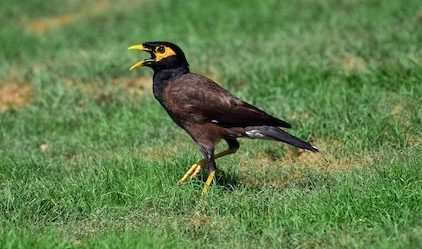
Common Myna, with bill open and showing full extent of yellow facial skin. (Ponnani Beach, Malappuram, Kerala, India; June 18, 2017.) © Mathew Thekkethela

Common Myna, adult with most of its facial feathers missing, revealing extensive yellow skin. (Lumphini Park, Bangkok, Thailand; November 4, 2019.) © Sergo Travelian

Common Myna, immature—lacking black hood. (Relau Metropolitan Park, Penang, Pulau Pinang, Malaysia; August 5, 2018.) © Neoh Hor Kee
The wings have white patches that are visible mainly in flight. On the upperside, the patch is limited to the base of the primaries. On the underside, the primary patch is larger and joins white wing-linings.
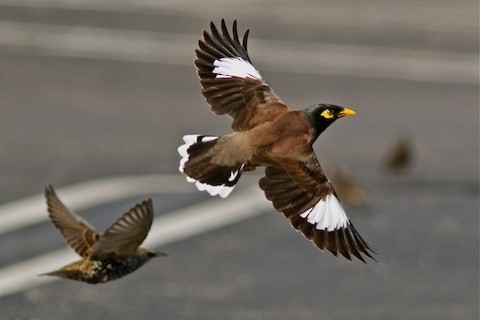
Common Myna, in flight, showing white wing-patches and tail-tip. (Miami, Florida; January 18, 2016.) © Bill Hill
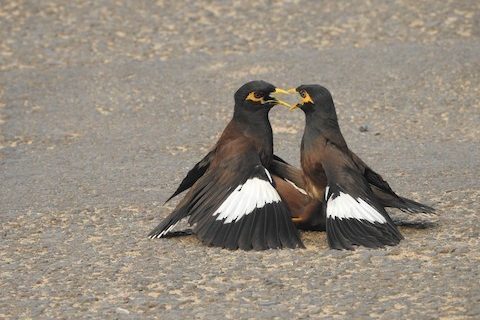
Common Mynas, squabbling and showing their white wing-patches. (Kannur, Kerala, India; February 19, 2017.) © Jameela P.

Common Myna, in flight, showing its black-and-white underwing pattern. (Lake Parramatta Reserve, New South Wales, Australia; March 9, 2019.) © Kent Warner

Common Mynas, apparently resorting to violence, with the victor showing its black-and-white underwing pattern. (Kamunting Ex-Mining Areas, Perak, Malaysia; April 21, 2018.) © Neoh Hor Kee

Common Myna, showing its distinctive white-and-black underwing pattern. (Sabaragamuwa Palata, Sri Lanka; April 23, 2016.) © Asiri Gauthamadsa

Common Myna, in the hand showing white on upperwing and uppertail. (Chokpak Ornithological Station, Ongtüstik Qazaqstan Oblysy, Kazakhstan; May 16, 2006.) © Arnau Bonan
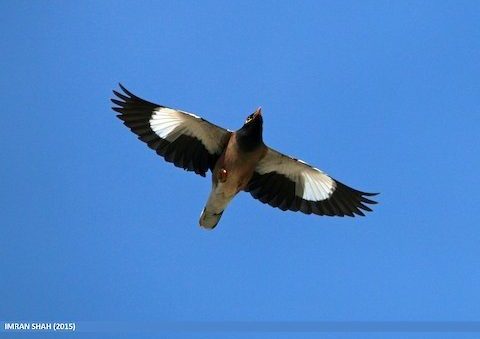
Common Myna, showing white-and-black underwing pattern and folded tail appearing all-white. (Islamabad, Pakistan; April 11, 2015.) © Imran Shah

Common Myna, showing its distinctive white-and-black underwing pattern. (Lake Sorbulak, Almaty Oblysy, Kazakhstan; June 6, 2011.) © Stanislav Harvančík
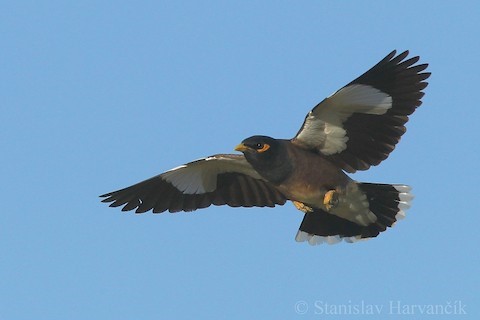
Common Myna, showing white-and-black underwing pattern and tail spread showing more black than white on the tail feathers. (Lake Sorbulak, Almaty Oblysy, Kazakhstan; June 6, 2011.) © Stanislav Harvančík

Common Myna, in an unusual mid-flight posture with tail spread and showing more black than white on the tail feathers. (Green Park Extension, New Delhi, India; March 7, 2018.) © Nitin Chandra
Notes
Polytypic species consisting of two recognized subspecies.
References
Alderfer, J., and J.L. Dunn. 2014. National Geographic Complete Birds of North America (Second Edition). National Geographic Society, Washington, D.C.
BirdLife International. 2017. Acridotheres tristis (amended version of 2016 assessment). The IUCN Red List of Threatened Species 2017: e.T22710921A111063735. https://dx.doi.org/10.2305/IUCN.UK.2017-1.RLTS.T22710921A111063735.en. (Accessed April 28, 2020.)
Brazil, M. 2009. Birds of East Asia. Princeton University Press, Princeton, N.J.
Craig, A., C. Feare, and E.F.J. Garcia. 2020. Common Myna (Acridotheres tristis). In Handbook of the Birds of the World Alive (J. del Hoyo, A. Elliott, J. Sargatal, D.A. Christie, and E. de Juana, eds.). Lynx Edicions, Barcelona. https://www.hbw.com/node/60874. (Accessed April 28, 2020.)
eBird. 2020. eBird: An online database of bird distribution and abundance. Cornell Lab of Ornithology, Ithaca, N.Y. http://www.ebird.org. (Accessed April 28, 2020.)
Feare, C., A. Craig, B. Croucher, C. Shields, and K. Komolphalin. 1999. Starlings and Mynas. Princeton University Press, Princeton, N.J.
Hawaii Audubon Society. 2005. Hawaii’s Birds (Sixth Edition). Island Heritage Publishing, Waipahu, Hawaii.
Pyle, R.L., and P. Pyle. 2017. The Birds of the Hawaiian Islands: Occurrence, History, Distribution, and Status. Version 2 (January 1, 2017). http://hbs.bishopmuseum.org/birds/rlp-monograph/. B.P. Bishop Museum, Honolulu, Hawaii.
Robson, C. 2002. Birds of Thailand. Princeton University Press, Princeton, N.J.
Sinclair, I., P. Hockey, W. Tarboton, and P. Ryan. 2011. Birds of Southern Africa (Fourth Edition). Random House Struik (Pty) Ltd. Cape Town, South Africa.
Xeno-Canto. 2020. Common Myna – Acridotheres tristis. https://www.xeno-canto.org/species/Acridotheres-tristis. (Accessed April 28, 2020.)
